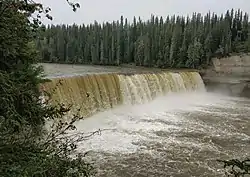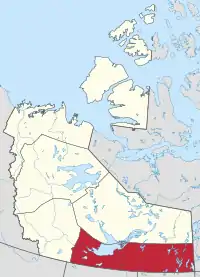South Slave Region | |
|---|---|
 Lady Evelyn Falls, Kakisa | |
 Location within the Northwest Territories | |
| Country | Canada |
| Territory | Northwest Territories |
| Federal riding | Northwest Territories |
| Territorial ridings | Deh Cho Hay River North Hay River South Thebacha Tu Nedhé-Wiilideh |
| Regional offices[1] | Fort Smith Hay River (sub-office) |
| Population (2016) | |
| • Total | 7,764 |
| Time zone | UTC−07:00 (MST) |
| • Summer (DST) | UTC−06:00 (DST) |
South Slave Region communities in the Northwest Territories
The South Slave Region is one of five administrative regions in the Northwest Territories of Canada. According to Municipal and Community Affairs the region consists of seven communities with the regional office situated in Fort Smith and a sub-office in Hay River.[1][2][3] With the exception of Enterprise and Hay River the communities are predominantly First Nations.
Communities
The South Slave Region includes the following communities:
| Community | Demographics (2016) | ||||||
|---|---|---|---|---|---|---|---|
| Name[4] | Type[5] | Census[6] | Aboriginal population profile[7] | ||||
| Official | Traditional | Total | First Nations | Métis | Inuit | Other | |
| Enterprise | Hamlet | 106 | 30 | 10 | 10 | 85 | |
| Fort Providence | Zhahti Kų́ę́ | Hamlet | 695 | 600 | 45 | 0 | 115 |
| Fort Resolution | Denı́nu Kų́ę́ | Hamlet | 470 | 385 | 50 | 10 | 105 |
| Fort Smith | Tthebacha | Town | 2,542 | 1,240 | 460 | 175 | 1,405 |
| Hay River | Xátł'odehchee | Town | 3,528 | 1,120 | 535 | 140 | 2,475 |
| Hay River Dene 1 | Xátł'odehchee | Indian reserve | 309 | 290 | 10 | 0 | 70 |
| Kakisa | K'ágee | Designated authority | 36 | Not enumerated | |||
|
| |||||||||||||||||||||||||||||||||||||||||||||||||||||||||
| Sources: NWT Bureau of Statistics (2001 - 2017). Does not include Kakisa as figures only available for five years.[8] | ||||||||||||||||||||||||||||||||||||||||||||||||||||||||||
References
- 1 2 South Slave Region
- ↑ Communities - South Slave
- ↑ Some government departments, such as the Bureau of Statistics, exclude Fort Providence, Hay River Dene 1 and Kakisa and put them in the Deh Cho Region. However, Municipal and Community Affairs indicates they are part of the South Slave Region
- ↑ "Northwest Territories Official Community Names and Pronunciation Guide". Prince of Wales Northern Heritage Centre. Yellowknife: Education, Culture and Employment, Government of the Northwest Territories. Archived from the original on 2016-01-13. Retrieved 2016-01-13.
- ↑ "Differences in Community Government Structures" (PDF). Maca.gov.nt.ca. Retrieved 18 December 2014.
- ↑ "Population and dwelling counts, for Canada, provinces and territories, and census subdivisions (municipalities), 2016 and 2011 censuses – 100% data".
- ↑ "Aboriginal Population Profile, 2016 census". Statistics Canada. Retrieved 1 July 2019.
- ↑ Population Estimates By Community from the GNWT
External links
This article is issued from Wikipedia. The text is licensed under Creative Commons - Attribution - Sharealike. Additional terms may apply for the media files.
